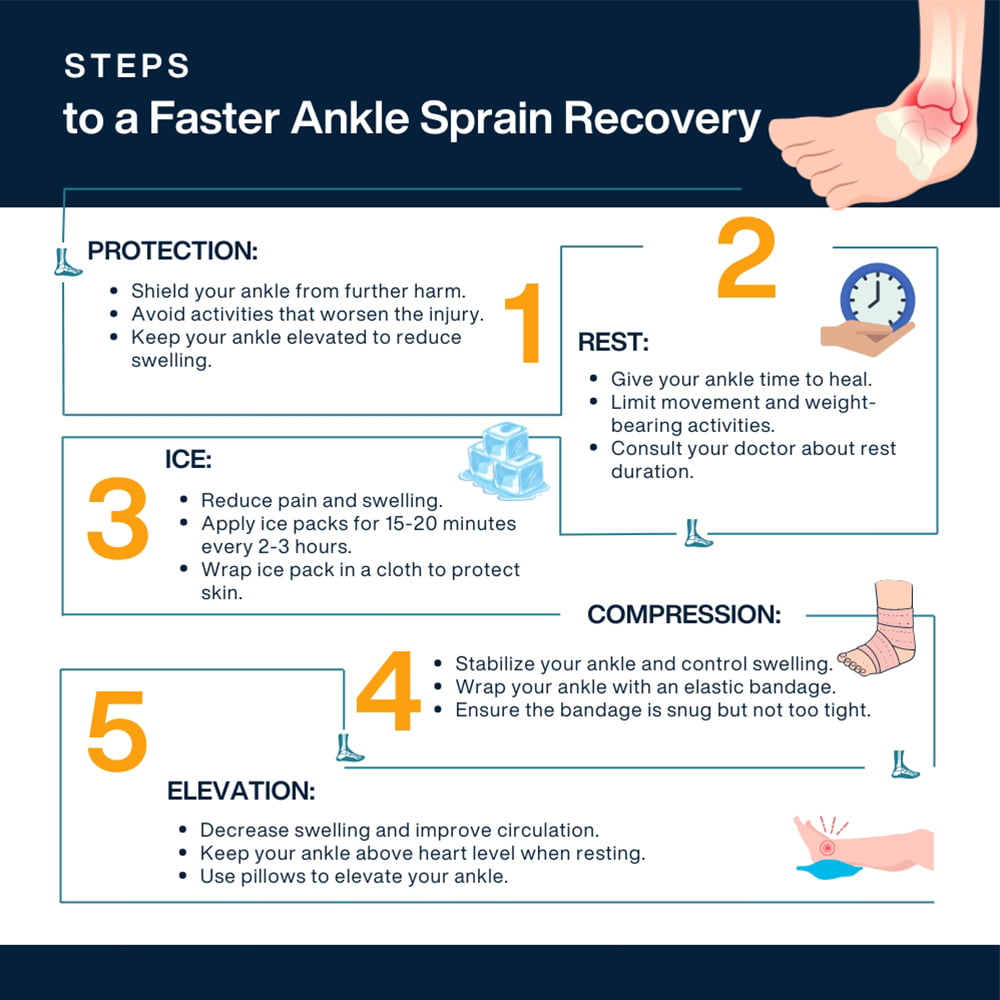Sprained ankles resulting from injury or fall can cause pain and swelling and put you off your feet for weeks. Luckily, there are several things you can do at home to speed healing, strengthen your muscles, and reduce the risk of re-injury. At Pain Management NYC, Dr. Leon Reyfman specializes in treating pain-related issues and recommends the safest and most effective treatments for ankle strains. He examines your joint to determine the extent of damage and comes up with a unique approach to pain care that significantly enhances your chances of a faster and more complete recovery.
Ankle sprains are common injuries that occur when the foot is rolled too far inward or at an awkward angle. Mild sprains usually heal on their own, but severe sprains that overstretch or break the ligaments or tissues can be painful and limit movement. They require months of healing as well as proper care.
Recovering from an ankle sprain is crucial to getting back on your feet and daily routine. Timely treatment can speed recovery and reduce the risk of a chronic or secondary injury and other complications that affect joint flexibility and mobility.
Read on to find out what to do after spraining an ankle and what steps you can take to boost your chances of a speedy recovery.
Steps to a Faster Ankle Sprain Recovery
If you have suffered an ankle sprain, it is best to act as quickly as possible. Home care can aid in faster and complete recovery, strengthen and mobilize your joints, and get you back to your feet in the least possible time.

Protection
The first step towards recovery and treatment is protecting the ankle from further injury and complications. It means avoiding activities that could aggravate the injury. It is necessary to take all the pressure off the ankle by lying down or sitting with the ankle elevated to reduce swelling.
Resting the ankle is crucial for healing, and wearing a brace can stabilize the injured area by limiting its movement. If needed, use crutches for a few days until your pain and swelling improve enough to allow walking. Attempting to return to sports and other routine activities too soon increases the risk of another injury.
Rest
Rest is essential for preventing additional stress on the injured ligaments. Get off your feet and rest as soon as you are diagnosed with an ankle sprain, and avoid activities that put weight on the injured ankle and cause pain, swelling, or discomfort. You should limit moving around, especially walking. Rest is the first part of the traditional RICE method for foot injuries. Taking some time to relax after an injury enables the body’s natural healing mechanisms to take action.
Give your sprained ankle the time to heal itself by resting for the first 72 hours. It also helps to keep the swelling down and manage pain. Ask your pain management doctor how long you should rest, and when you can resume light activity. Not walking for more than a few days can result in ankle stiffness and weakness.
Icing
Sprained or torn ligaments in the ankle result in pain and swelling. You can keep the pain and swelling down by icing the affected area. The best way is to use an ice bag, premade ice pack, a bag of frozen vegetables, or you can make your own ice bag by filling a freezer bag with ice cubes and water. Do not apply ice cubes or frozen objects directly onto the skin. This will result in freezer burn as well as tissue damage.
The best way to ice the joint is by wrapping an ice pack in a thin towel or wash cloth and placing it on your ankle for 15-20 minutes every two to three hours. You can also dip your ankle in an ice bath for 15 to 20 minutes. While you are resting your ankle, icing it will relieve some of the pain and swelling.
If you have diabetes, vascular disease, or decreased sensation of any kind, check with your doctor if applying ice is safe for you. Icing any part of the skin with decreased sensation can freeze it, which may lead to frostbite.
Compression
Compression helps stabilize the injured joint and prevents further swelling. When you get injured, your body starts an inflammatory process that sends extra fluid to the injury to carry away damaged cells, but all that fluid can cause some swelling and discomfort. It involves wrapping the foot with an elastic bandage or a tensor for 48 to 72 hours, which will rest the joint and keep too much fluid from accumulating on it.
As the ankle is wrapped and immobilized, you are less likely to aggravate the sprain. It is best to wrap the foot all the way from the toes to the mid-calf region. The bandage should be snug, but not so tight that it digs into the skin, hurts, or causes numbness. Mild pressure that is not too uncomfortable or tight, and does not stop blood flow is ideal. Your foot should be comfortable enough to move.
Elevating
Elevating an injured ankle above your waist or heart as much as possible during the recovery period, particularly for the first 24 to 48 hours after the sprain, reduces the accumulation of fluid in the joint.
The gravity pulls excess fluid away from your ankle, which eases swelling and reduces pain as well. It allows the body to heal inflammation more quickly and enhances circulation in the leg. Instead of having to work to combat the excess fluid in the area, your body can work on combating inflammation at the joint, which can help your ankle heal faster.
Try sleeping with the foot and ankle propped up on pillows at a level higher than the heart. When sitting or resting, use pillows or a footrest to keep the foot and ankle elevated. It will also provide some comfort for your leg.
Related Articles: What Can Cause Ankle Pain Without Injury?
Other Things You Can Do to Help Your Ankle Heal Faster
There are various things you can do to aid in the ankle sprain recovery process. They include:
Heat
Heat increases blood flow to the injury, which can speed healing once the initial swelling has gone down. It also relaxes the tight muscles, easing pain and tension. Try applying a heat pack for 15 to 20 minutes at a time. You can also alternate between heat and ice packs.
However, you need to understand that heating should not be used immediately after the injury or until the ankle is swollen, or it will increase inflammation and slow the healing process.
Stretching
An injury to the ankle puts nearby muscles and other structures at risk of damage. This often happens when the tissues become weak from disuse. Stretching keeps the muscles strong and limber. It enhances blood circulation to the area, which supports quick healing.
After the first couple of days of elevating and resting, start stretching the ankle gently by moving it in all directions at least three times a day. Flexing the foot forward, then backward, or rolling it clockwise then counterclockwise restores strength, and improves flexibility and range of motion. Do not overexert your ankle or move it in any direction that hurts to prevent further damage.
Walking
The pain and swelling immediately after an ankle sprain are severe and make it impossible to put your weight on the joint or walk. However, as the swelling goes down and the pain subsides, you should start walking short distances within the house.
Walking promotes healing, and the quicker you can get to the point where you start to put some weight on your sprained ankle, the better your recovery will be. Make sure to put only as much weight on your foot as it is comfortable at first. Slowly work your way up to your full weight.
Massage
Massaging your ankle about 72 hours after the injury can reduce the pain and swelling by promoting blood flow to the sprained area. Certain techniques may even help break down scar tissue. However, you have to be careful and make sure it does not cause pain.
Start with small circular motions around the affected area gently, and use your fingertips so you don’t apply too much pressure. You may experience a little discomfort during the massage, especially during the cross-friction part of the massage. Stop massaging if it causes pain or worsens symptoms. If the injury is severe or painful, consult your doctor.
Physical therapy
Physical therapy is especially beneficial for those who experience long-term pain following a serious sprain or similar injuries. It helps to reduce pain and swelling, regain strength, and balance and return to normal activities gradually.
A physical therapist will examine your ankle to identify weak muscles and other issues that cause pain and increase the risk of injury. They come up with customized exercise plans that focus on easing the pain, protecting the joint and its ligaments from further injury, and promote long-term healing.
Non-steroidal anti-inflammatory drugs (NSAIDs)
You may need pain-relieving medications to keep the pain down and support the recovery process. While over-the-counter medications may help with pain, they cannot do anything for your injury. Non-steroidal anti-inflammatory drugs (NSAIDs) can counter the effects of inflammation, such as swelling, more effectively.
Your doctor can prescribe NSAIDs to manage the pain and swelling.
Remember, each ankle sprain is unique. Following the right recovery plan that addresses your specific needs can help you get back to your feet and active lifestyle in the least possible time.
Related Articles: Common Causes of Pain in the Back of the Ankles
When to See a Doctor for Your Sprained Ankle?
Sprains usually do not require casts and often heal on their own. If the pain is mild and you prefer home treatment, you can wait a day or two. However, if you have sprained your ankle as a result of an injury or a fall, have severe pain, cannot put any weight on the ankle at all, and the swelling does not go down, visit a doctor.
Sometimes sprains are serious, and you have additional injuries such as broken bones or torn ligaments, which need medical attention. A doctor will examine your foot to assess the severity of your sprain and recommend the best treatment for faster healing. Delaying medical attention in such cases can delay rehabilitation.
Do you need help with your ankle sprain – Call Pain Management NYC today, and schedule an appointment with Dr. Leon Reyfman for a quick and easy recovery from your ankle pain. Dr. Leon Reyfman is a sports injury doctor and highly rated pain management specialist in NYC. He figures out the causes behind your ankle pain and explains how you can regain ankle function and minimize the risk of future injuries to enjoy a pain-free life. He comes up with personalized treatment plans that focus on your individual needs and ensure you return to your routine activities and movements as soon as possible.

Leon Reyfman, MD, is a top-rated, best-in-class interventional pain management doctor. He is a nationally recognized pain relief specialist and is among the top pain care doctors in New York City and the country. He is an award-winning expert and contributor to prominent media outlets.
Dr. Leon Reyfman has been recognized for his thoughtful, thorough, modern approach to treating chronic pain. He has been named a “top pain management doctor in New York” and one of “America’s Top Doctors™” for advanced sports injury treatments. Among other accolades, he was voted by peers as a “Castle Connolly Top Doctors™” and “New York Super Doctors™”. Dr. Leon Reyfman was a part of the medical team at the 2016 Summer Olympic Games in Rio de Janeiro, Brazil.
